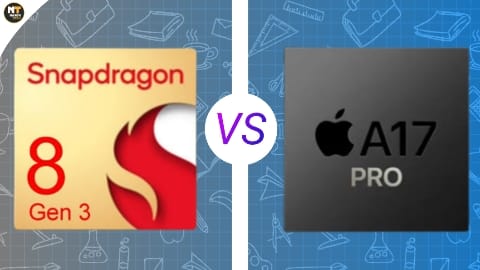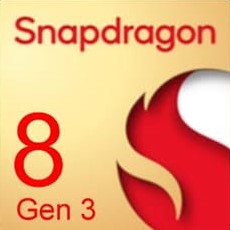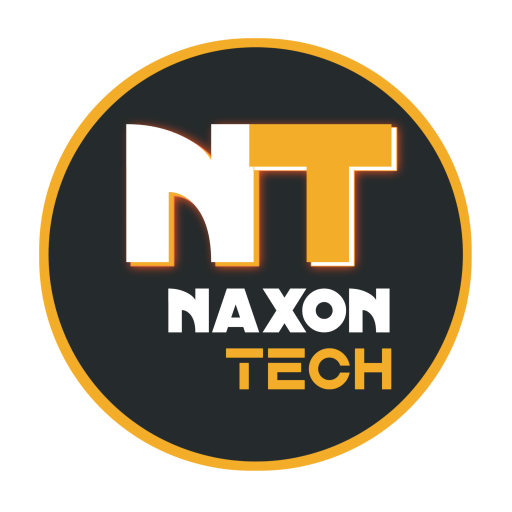Qualcomm Snapdragon 8 Gen 3 vs Apple A17 Pro, the battle for the best chipset is a fierce one. These two contenders are currently leading the pack, promising unparalleled performance and cutting-edge technology. In this article, we will delve into the specifications and performance metrics of both chipsets, comparing their strengths and weaknesses.

Table of Contents
Snapdragon 8 Gen 3 vs Apple A17 Pro
Performance Metrics
AnTuTu Benchmark: The AnTuTu Benchmark is a comprehensive test that evaluates CPU, GPU, RAM, and I/O performance. In this test, the Snapdragon 8 Gen 3 boasts an impressive score of 2,008,000*, showcasing its superior capabilities. On the other hand, the Apple A17 Pro achieves a commendable score of 1,579,000*, indicating robust performance but falling slightly behind the Snapdragon counterpart.
GeekBench 6: In the GeekBench test, which assesses single-threaded and multi-threaded CPU performance, the Apple A17 Pro take the lead in both the multi-core score with a score of 7,450* and single-core score with a score of 2970 while SD 8 Gen 3 achieves 7350* in a multi-core score and 2200 in the single-core test.
CPU and GPU Architecture
Snapdragon 8 Gen 3: The Snapdragon 8 Gen 3 features a powerful octa-core CPU based on 4nm architecture, including 1x Cortex-X4, 5x Cortex-A720, and 2x Cortex-A520 cores. This blend of high-performance and energy-efficient cores ensures optimal performance across various tasks. It is coupled with Adreno 750 GPU which operates at 770 MHz, delivering exceptional graphics rendering capabilities.
Apple A17 Pro: The Apple A17 Pro boasts a hexa-core CPU architecture and is designed on 3nm architecture featuring a mix of high-performance and efficient cores. Its Apple A17 GPU operates at 1,398 MHz, providing seamless graphics performance for demanding applications and games.
Memory and Connectivity
Snapdragon 8 Gen 3: The SD 8 Gen 3 supports LPDDR5X RAM with a maximum frequency of 4,800 MHz, offering lightning-fast data access and multitasking capabilities. Its connectivity features include 5G support with download speeds of up to 10,000 Mbps, Wi-Fi 7, and Bluetooth 5.4, ensuring high-speed data transfer and reliable wireless connections.
Apple A17 Pro: The A17 Pro supports LPDDR5 RAM with a maximum frequency of 3,200 MHz, providing efficient multitasking and app performance. Its connectivity options include 5G support with download speeds of up to 7,500 Mbps, Wi-Fi 6, and Bluetooth 5.3, ensuring seamless connectivity experiences.
| Specifications | Snapdragon 8 Gen 3 | Apple A17 Pro |
|---|---|---|
 |  | |
| AnTuTu Benchmark Score | 2,008,000* (* score varies from device to device) | 1,579,000*| (* score varies from device to device) |
| GeekBench Single-Core | 2,200* | 2,970* |
| GeekBench Multi-Core | 7,350* | 7,450* |
| CPU Architecture | 1x 3.3 GHz – Cortex-X4, 3x 3.15 GHz – Cortex-A720, 2x 2.96 GHz – Cortex-A720, 2x 2.26 GHz – Cortex-A520 | 2x 3.78 GHz, 4x 2.11 GHz |
| GPU Architecture | Adreno 750 (770 MHz) | Apple A17 GPU (1,398 MHz) |
| RAM Type | LPDDR5X (4x 16 Bit, 4800 MHz) | LPDDR5 (4x 16 Bit, 3200 MHz) |
| Maximum RAM Size | 24 GB | 8 GB |
| Process Technology | 4 nanometers | 3 nanometers |
| 5G Support | Yes (Up to 10,000 Mbps download) (Up to 3,500 Mbps upload) | Yes (Up to 7,500 Mbps download) (Up to 3,500 Mbps upload) |
| Wi-Fi | Wi-Fi 7 | Wi-Fi 6 |
| Bluetooth | 5.4 | 5.3 |
| Announced | October 2023 | September 2023 |
| Class | Flagship | Flagship |
Snapdragon 8 Gen 3 vs Apple A17 Pro: Conclusion
Both the Snapdragon 8 Gen 3 and the Apple A17 Pro are powerful contenders in the world of chipsets, catering to the demands of modern smartphones. While the Snapdragon 8 Gen 3 excels in raw performance, the A17 Pro offers a balanced approach with efficient energy usage and robust multitasking capabilities. Ultimately, the choice between these chipsets depends on individual preferences and the specific requirements of the device in which they are implemented.


